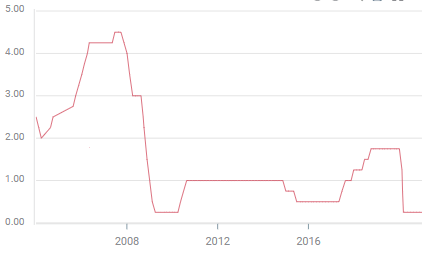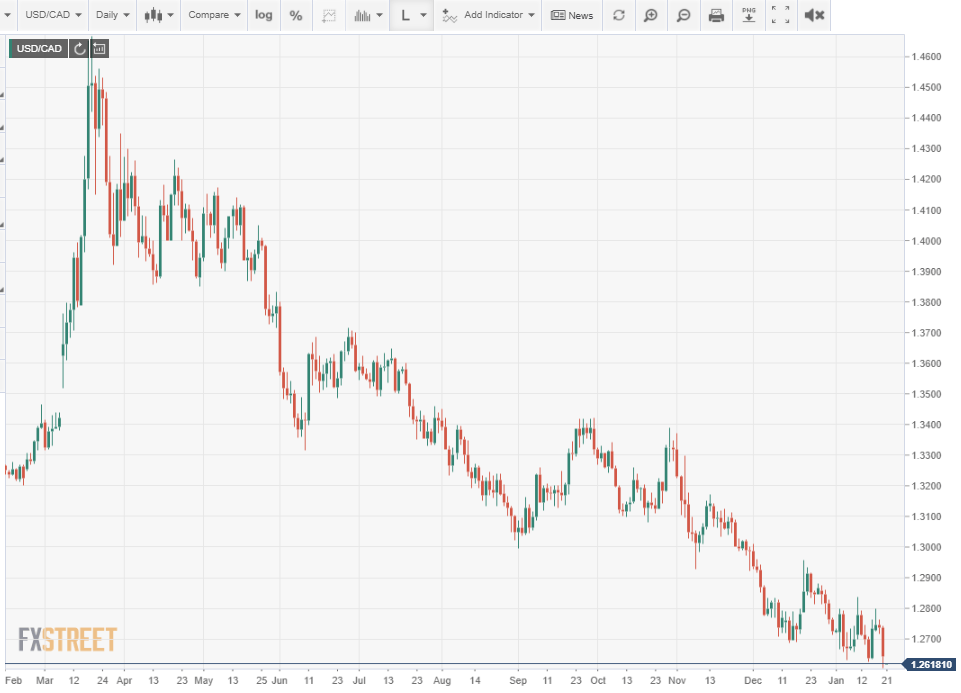- Band of Canada leaves rates, quantitative easing unchanged.
- Canadian dollar rises to 33-month high after statement.
- BoC cites improved economic outlook, stronger commodity prices for currency appreciation.
- Bank does not expect inflation at 2% target until 2023.
Official economic optimism is in short supply everywhere. The Bank of Canada's (BoC) guarded invocation was enough to drive the Canadian dollar to a 33-month high of 1.2603 at the release of the December rate decision on Wednesday.
There had been no market expectation for a change in either the 0.25% overnight lending rate or the C$4 million a week in quantitative easing purchases. Journalists had speculated that in light of the weak December employment report the bank might opt for a reduction less than the standard 0.25%.
Bank of Canada overnight lending rate
What was unforeseen, given that much of the Canadian economy is locked down, was the bank's straightforward optimism about the vaccine and its impact on second half growth.
“Assuming restrictions are lifted later in the first quarter, the Bank expects a strong second-quarter rebound. Consumption is forecast to gain strength as parts of the economy reopen and confidence improves, and exports and business investment will be buoyed by rising foreign demand,” said the statement accompanying the decision.
“After a decline in real GDP of 5½ percent in 2020, the Bank projects the economy will grow by 4 percent in 2021, almost 5 percent in 2022, and around 2½ percent in 2023.“
USD/CAD
The Canadian dollar has been on somewhat of a tear over the past two months.
Since the middle of November the loonie had gained 3.3% against the greenback to the open on Wednesday. The US dollar's woes were homegrown as the labor recovery slowed and then in December reversed with Nonfarm payrolls shedding 140,00 position, the first loss since April.
Rising commodity prices in anticipation of a global recovery in the second and third quarters helped the Canadian dollar as well. West Texas Intermediate, the North American crude standard, rose 50% from November 2 to January 14, closing at $53.68.
Canada's largest trade partner is the United States and a rising local dollar puts her exports at a expense disadvantage.
This was noted by Bank of Canada Governor Tiff Macklem who had said that “recent Canadian dollar appreciation is hurting the competitiveness of Canadian exporters in the US market." The policy statement of the December 9 BoC meeting commented that, “A broad based decline in the US exchange rate has contributed to a further appreciation of the Canadian dollar. “
These statements prompted some anticipation that the bank or Governor Macklem in his presentation, might try to talk down the Canadian dollar from its perch, notwithstanding the general ineffectiveness of such rhetoric.
In the event, the BoC simply observed that, “A broad-based decline in the US exchange rate combined with stronger commodity prices have led to a further appreciation of the Canadian dollar,” a statement of fact and nothing else.
As the USD/CAD dropped 47 points in the first five minutes after the release of the BoC statement at 10:00 am (1.2698-1.2651) and 69 points to 1.2629 within 15 minutes, it was clearly the bank's official optimism on the economy and its equanimity on the Canadian dollar that prompted USD/CAD sellers. On the day the USD/CAD opened at 1.2736 and finished at 1.2643.
Governor Macklem's optimism was slightly more measured. “In sum, there is clear reason to be more optimistic about the direction of the economy over the medium term. But we are not there yet. The resurgence in COVID-19 cases weighs heavily on the near-term outlook. And this underlines the ongoing need for extraordinary fiscal and monetary policies,” he said in his prepared comments.
Inflation, the step-child of central bank policy everywhere, was put off into a more positive future. “Excess supply [of gasoline] is expected to weigh on inflation throughout the projection period. As it is absorbed, inflation is expected to return sustainably to the 2 percent target in 2023,” said the BoC statement.
The Bank of Canada's relative good cheer about the economy is a surprising plus for its currency.
Information on these pages contains forward-looking statements that involve risks and uncertainties. Markets and instruments profiled on this page are for informational purposes only and should not in any way come across as a recommendation to buy or sell in these assets. You should do your own thorough research before making any investment decisions. FXStreet does not in any way guarantee that this information is free from mistakes, errors, or material misstatements. It also does not guarantee that this information is of a timely nature. Investing in Open Markets involves a great deal of risk, including the loss of all or a portion of your investment, as well as emotional distress. All risks, losses and costs associated with investing, including total loss of principal, are your responsibility. The views and opinions expressed in this article are those of the authors and do not necessarily reflect the official policy or position of FXStreet nor its advertisers. The author will not be held responsible for information that is found at the end of links posted on this page.
If not otherwise explicitly mentioned in the body of the article, at the time of writing, the author has no position in any stock mentioned in this article and no business relationship with any company mentioned. The author has not received compensation for writing this article, other than from FXStreet.
FXStreet and the author do not provide personalized recommendations. The author makes no representations as to the accuracy, completeness, or suitability of this information. FXStreet and the author will not be liable for any errors, omissions or any losses, injuries or damages arising from this information and its display or use. Errors and omissions excepted.
The author and FXStreet are not registered investment advisors and nothing in this article is intended to be investment advice.
Recommended Content
Editors’ Picks
EUR/USD hovers around 1.0700 after German IFO data

EUR/USD stays in a consolidation phase at around 1.0700 in the European session on Wednesday. Upbeat IFO sentiment data from Germany helps the Euro hold its ground as market focus shifts to US Durable Goods Orders data.
USD/JPY refreshes 34-year high, attacks 155.00 as intervention risks loom

USD/JPY is renewing a multi-decade high, closing in on 155.00. Traders turn cautious on heightened risks of Japan's FX intervention. Broad US Dollar rebound aids the upside in the major. US Durable Goods data are next on tap.
Gold price trades with mild negative bias, manages to hold above $2,300 ahead of US data

Gold price (XAU/USD) edges lower during the early European session on Wednesday, albeit manages to hold its neck above the $2,300 mark and over a two-week low touched the previous day.
Worldcoin looks set for comeback despite Nvidia’s 22% crash Premium

Worldcoin price is in a better position than last week's and shows signs of a potential comeback. This development occurs amid the sharp decline in the valuation of the popular GPU manufacturer Nvidia.
Three fundamentals for the week: US GDP, BoJ and the Fed's favorite inflation gauge stand out Premium

While it is hard to predict when geopolitical news erupts, the level of tension is lower – allowing for key data to have its say. This week's US figures are set to shape the Federal Reserve's decision next week – and the Bank of Japan may struggle to halt the Yen's deterioration.


